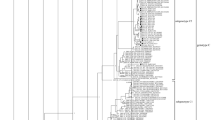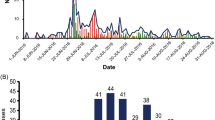Abstract
The objective was to investigate the genetic relationships among Echovirus 6 (E6) strains circulating in Greece and to compare them with the respective strains from other geographic regions. Cerebrospinal fluid samples collected during the period 2006–2007 from 84 patients with aseptic meningitis or encephalitis were tested for a probable enteroviral infection. Two RT-PCRs amplifying overlapping regions of the VP1 gene were performed, while isolation procedures were applied in one third of cases. All PCR products were sequenced, and further phylogenetic analysis was performed for E6 strains. Enteroviruses were detected in 27 out of 84 cases (32.14%) and E6 was the predominant serotype (11 out of 27, 40.74%). Three distinct clades of Greek E6 sequences were seen in the phylogenetic tree: sequences of the present study were placed in clades A and B, while sequences of a former study in Greece were clustered in clade C. Sequences of clades A and C presented high genetic homology (>95%) with sequences from other countries, while sequences of clade B were unique, differing by more than 15% from all known E6 sequences. The most prevalent enterovirus in Greece during the period 2006–2007 was E6, and was associated with aseptic meningitis. A high degree of heterogeneity was observed among Greek E6 strains.

Similar content being viewed by others
References
Ashwell MJ, Smith DW, Phillips PA et al (1996) Viral meningitis due to echovirus types 6 and 9: epidemiological data from Western Australia. Epidemiol Infect 117:507–512
Chomel JJ, Antona D, Thouvenot D et al (2003) Three ECHOvirus serotypes responsible for outbreak of aseptic meningitis in Rhone-Alpes region, France. Eur J Clin Microbiol Infect Dis 22:191–193
Abe O, Kimura H, Minakami H et al (2000) Outbreak of gastroenteritis caused by echovirus type 6 in an orphanage in Japan. J Infect 41:285–286. doi:10.1053/jinf.2000.0748
Boyd MT, Jordan SW, Davis LE (1987) Fatal pneumonitis from congenital echovirus type 6 infection. Pediatr Infect Dis J 6:1138–1139
Ventura KC, Hawkins H, Smith MB et al (2001) Fatal neonatal echovirus 6 infection: autopsy case report and review of the literature. Mod Pathol 14:85–90. doi:10.1038/modpathol.3880260
Khetsuriani N, Lamonte-Fowlkes A, Oberst S et al (2006) Centers for Disease Control and Prevention. Enterovirus surveillance—United States, 1970–2005. MMWR Surveill Summ 55:1–20
Mirand A, Henquell C, Archimbaud C et al (2008) Prospective identification of enteroviruses involved in meningitis in 2006 through direct genotyping in cerebrospinal fluid. J Clin Microbiol 46:87–96. doi:10.1128/JCM.01020-07
Cabrerizo M, Echevarria JE, González I et al (2008) Molecular epidemiological study of HEV-B enteroviruses involved in the increase in meningitis cases occurred in Spain during 2006. J Med Virol 80:1018–1024. doi:10.1002/jmv.21197
Reznik VI, Kozhevnikova NV, Karavianskaia TN et al (2007) Epidemiologic and etiologic characteristic of enterovirus infections in Khabarovsk region. Zh Mikrobiol Epidemiol Immunobiol 5:32–37
Richter J, Koptides D, Tryfonos C et al (2006) Molecular typing of enteroviruses associated with viral meningitis in Cyprus, 2000–2002. J Med Microbiol 55:1035–1041. doi:10.1099/jmm.0.46447-0
Siafakas N, Markoulatos P, Levidiotou-Stefanou S (2004) Molecular identification of enteroviruses responsible for an outbreak of aseptic meningitis; implications in clinical practice and epidemiology. Mol Cell Probes 18:389–398. doi:10.1016/j.mcp.2004.06.005
Dumaidi K, Frantzidou F, Papa A et al (2006) Enterovirus meningitis in Greece from 2003–2005: diagnosis, CSF laboratory findings, and clinical manifestations. J Clin Lab Anal 20:177–183. doi:10.1002/jcla.20129
Frantzidou F, Dumaidi K, Spiliopoulou A et al (2007) Echovirus 15 and autumn meningitis outbreak among children, Patras, Greece, 2005. J Clin Virol 40:77–79. doi:10.1016/j.jcv.2007.06.003
Casas I, Palacios GF, Trallero G et al (2001) Molecular characterization of human enteroviruses in clinical samples: comparison between VP2, VP1, and RNA polymerase region using RT nested PCR assays and direct sequencing of products. J Med Virol 65:138–148. doi:10.1002/jmv.2013
Oberste MS, Maher K, Williams AJ et al (2006) Species-specific RT-PCR amplification of human enteroviruses: a tool for rapid species identification of uncharacterized enteroviruses. J Gen Virol 87:119–128. doi:10.1099/vir.0.81179-0
Lévêque N, Norder H, Zreik Y et al (2007) Echovirus 6 strains derived from a clinical isolate show differences in haemagglutination ability and cell entry pathway. Virus Res 130:1–9. doi:10.1016/j.virusres.2007.05.006
Oberste MS, Maher K, Kilpatrick DR, Pallansch MA (1999) Molecular evolution of the human enteroviruses: correlation of serotype with VP1 sequence and application to picornavirus classification. J Virol 73:1941–1948
Kottaridi C, Bolanaki E, Siafakas N et al (2005) Evaluation of seroneutralization and molecular diagnostic methods for echovirus identification. Diagn Microbiol Infect Dis 53:113–119. doi:10.1016/j.diagmicrobio.2005.06.016
Roth B, Enders M, Arents A et al (2007) Epidemiologic aspects and laboratory features of enterovirus infections in Western Germany, 2000–2005. J Med Virol 79:956–962. doi:10.1002/jmv.20917
Acknowledgements
We thank Mrs. A. Agelatou, at the Children′s Hospital of Patras, for the collection of samples. The study was financially supported by the Hellenic Center for Disease Control and Prevention.
Author information
Authors and Affiliations
Corresponding author
Rights and permissions
About this article
Cite this article
Papa, A., Skoura, L., Dumaidi, K. et al. Molecular epidemiology of Echovirus 6 in Greece. Eur J Clin Microbiol Infect Dis 28, 683–687 (2009). https://doi.org/10.1007/s10096-008-0685-1
Received:
Accepted:
Published:
Issue Date:
DOI: https://doi.org/10.1007/s10096-008-0685-1




